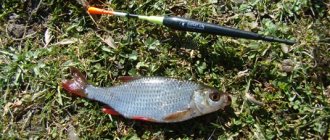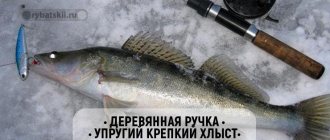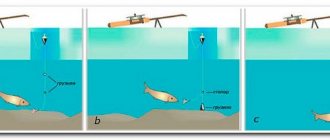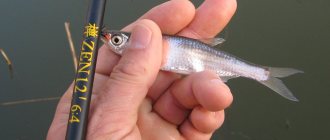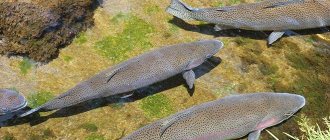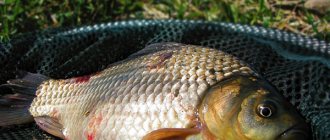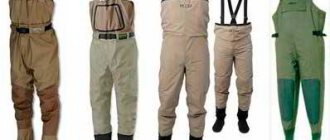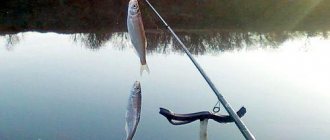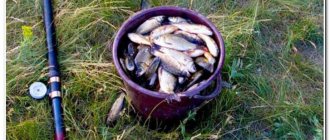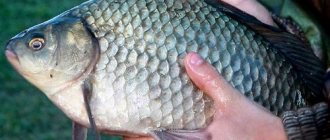Rods for float fishing
Depending on what type of reservoir and under what conditions the fishing takes place, the angler uses different types of float rods. Fishing rods for float fishing are divided into 4 categories:
- flight feathers;
- Bolognese;
- match;
- plug-in
Flight feathers are the most common group, used for fishing in stagnant bodies of water or on rivers with moderate currents. The casting range when fishing with fly tackle is determined by the length of the rod, which can range from 3 to 12 m. Due to the limited casting range, fly rods are used to fish in small bodies of water or in places where the channel edge or hole is located in close proximity to the shore.
The Bolognese float rod is used for fishing on rivers with weak and medium currents. This tackle is equipped with a spinning reel and rings, which allows you to fish at some distance from the shore. The length of Bolognese fishing rods ranges from 4 to 8 meters.
Match float tackle is used for long-distance fishing. The match fishing rod is equipped with an inertia-free reel and a heavy float with its own weight, which allows you to cast the equipment 30–60 m from the shore. The length of fly rods rarely exceeds 6 m.
A plug rod for float fishing can be used in both standing and flowing reservoirs. It is more often used by sports fishermen, since it requires certain handling skills. Plug fishing rods are equipped with a rubber shock absorber located inside the working part of the rod, which is called the “whale”. The length of such fishing rods reaches 15 m.
Tips for choosing a float rod with a blind rig
When choosing a float rod with a blind rig, pay attention to the following points:
- The cheapest option for novice fishermen would be fiberglass rods. They are in the price range from 300 to 500 rubles.
- If you want to buy a higher quality device, then it is better to opt for a simple carbon rod. It is much more sensitive and lighter.
- It is not necessary to purchase the most expensive reel; it is best to get a device with 1-2 bearings from a reliable manufacturer.
- In this case, the fishing line is used with a length of about 100 meters. Experienced fishermen usually take a thinner line, but for a beginner it is better to have a margin of safety.
In order to protect yourself from its rupture under strong tension, you should cut off approximately 5 meters from the total length after every 10 active fishing trips.
It is also worth paying attention to products made from fluorocarbon, as they are barely noticeable in the water, sink well and practically do not stretch. They may cost more than usual, but they have their obvious advantages.
Peculiarities
The blind rig of a float fishing rod has the following disadvantages:
- lack of ability to adjust the length of the fishing line;
- the presence of a complex process for replacing equipment in the event of breaks, which happen quite often.
The Bolognese fishing rod does not have all these disadvantages; its reel is responsible for lubricating and winding the fishing line and does not participate in the fishing process at all. This fishing rod is an improved version of the fly rod.
How to catch more fish?
I have been active fishing for quite some time and have found many ways to improve the bite. And here are the most effective:
- Bite activator. Attracts fish in cold and warm water with the help of pheromones included in the composition and stimulates its appetite. It’s a pity that Rosprirodnadzor wants to impose a ban on its sale.
- More sensitive gear. Reviews and instructions for other types of gear can be found on the pages of my website.
- Lures using pheromones.
You can get the rest of the secrets of successful fishing for free by reading our other articles on the site.
Nowadays, there are two types of Bolognese fishing rods: telescopic and plug-in. The first option is the most popular and has a low cost, while the second is significantly more expensive due to the large number of fittings.
The peculiarity of this device is that when using two sliding rings, the tension on the rod when fishing is reduced.
The Bolognese method allows you to fish in various conditions and over long distances. The rings also distribute the load on the blank when catching large specimens. This reduces the possibility of tool breakage.
Dimensions
The smartest choice for everyday fishing would be to purchase a 4 meter fishing rod. With a shorter length it will be too short, and longer options will create difficulties when casting.
Preparation method

To properly install a fixed float on a fishing rod, you will definitely need to perform the following sequence of actions:
- Choose a fishing line with a diameter of 0.12 to 0.14 mm and a length of approximately 10 centimeters; it will be needed to make a leash.
- Choose a hook depending on the bait. When using a worm as bait, you should take a device with a long shank, and if you took dough, then the best option would be short hooks with a wide shank.
- Assemble the crusher weight; it is located above the connecting node, and is clamped both on the leash and on the main fishing line.
- Buy rubber or PVC cambrics.
- To decide on a float, for example, you can use a quill pen. It is chosen because of its high sensitivity and because it is clearly visible even at great distances. Thanks to this float you will not miss even a slightly noticeable bite.
The equipment process itself is as follows:
- we pass the fishing line through rubber cambrics;
- we pull them together with the fishing line onto the float;
- we connect the remaining end of the fishing line to the leash using a knot;
- we clamp the crusher on the main line or on a leash;
- We tie the hook to the wiring.
This type of equipment is chosen when fishing for crucian carp and rudd in overgrown reservoirs.
Necessary elements for float tackle
The presence of certain elements in the equipment depends on the type of float rod. The blind equipment of a float rod for fly fishing includes:
- connector;
- main line;
- float;
- set of weights;
- leash;
- hook.
The connector is used to attach the main line to the rod and can be made in various versions. The main equipment is concentrated on the main line, which includes a float and a set of sinkers. Floats for fly fishing can have a body of various shapes, equipped with a keel, antenna, and also a ring for passing the fishing line. Their load capacity can range from 0.1 to 10 g. A set of sinkers consists of lead pellets of various weights, which are necessary to load the float.

Connectors
A leash is a necessary element that protects the entire equipment from breaking if the hook gets caught. Its diameter is usually 0.02 less than the diameter of the main line. The hook is used to attach bait and ensure reliable hooking. Its size is selected taking into account the type and size of the nozzle.
The equipment of a Bolognese fishing rod differs from that used for fly fishing gear. The equipment of a float rod for fishing in currents consists of the following elements:
- rods with rings;
- inertia-free or inertial coil;
- main line;
- Bolognese float;
- olive sinkers;
- swivel;
- leash;
- hook.
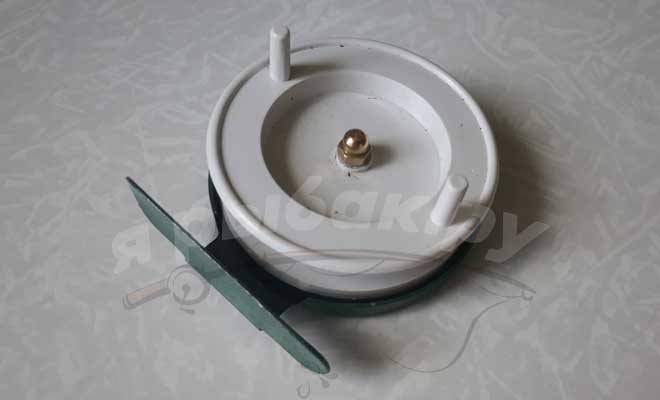
The Bologna rig includes an inertia-free reel of size 3000–3500, on the spool of which a monofilament line with a diameter of 0.15–0.18 mm is wound. It would be good if the reel had a large additional number of bearings, which would allow you to quickly reel out the line after a single hookup. The Bolognese float differs from the fly float in having a greater load capacity and a through hole for passing fishing line. The swivel is necessary to prevent the leash from twisting in the stream. The size of the hook for fishing with Bolognese tackle is usually slightly larger than that used for fishing in still water. This is due to the fact that fish in the current take the bait more boldly and resist more desperately.
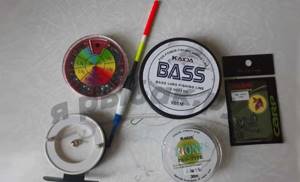
Elements for equipping float tackle
The equipment of the plug tackle differs from the fly version by using thinner lines and light floats, which makes it possible to catch capricious fish. The match gear is characterized by the presence of an inertia-free reel and a heavy float, which has its own carrying capacity and ensures long-distance casting of the nozzle.
Blind rig on a fishing rod
The equipment is called blind because the length of the fishing line from the rod to the hook does not change. The line is attached directly to the tip of the fishing rod, and the reel is not used. On the one hand, a fishing rod with a blind rig has some limitations - you cannot return the line if the float is carried away by the current or when a large fish is caught. But on the other hand, the tackle turns out to be the simplest, most mobile, lightweight, and suitable for high-speed fishing of small and medium-sized fish. Such a fishing rod with a blind rig is called a fly rod.
Features of a fishing rod with a blind rig
The difficulty of landing large fish without a reel should not create prejudice towards blind equipment. If only because large fish on a fly rod are still rare for novice fishermen. And modern, very thin fishing lines make it possible to compete with blind tackle against fairly decent specimens weighing more than 1 kg. The more significant issue is the limited fishing distance. Sometimes on shallow water shores this becomes the main reason for replacing the fly fishing rod with other types of tackle.
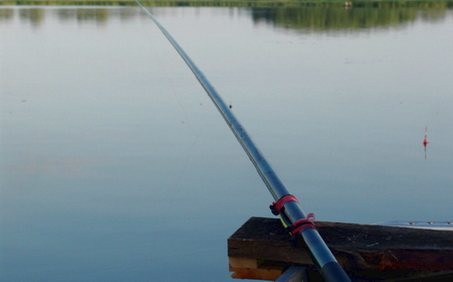
Now about the advantages of a fishing rod with a blind rig.
- The tackle is extremely simple. Even a child can operate it. Fishing practice, as a rule, begins with a fishing rod with blind equipment.
- The gear is mobile and does not require bulky equipment. Everything you need for fishing with a fishing rod with a blind rig can literally be in your pockets... The ability to search for fish and running fishing, surveying places, extreme maneuverability - this is what makes a fly rod unrivaled.
- Possibility of high-speed fishing with active biting. No other tackle can fish as quickly as a fly rod. For novice fishermen it may not seem significant, but athletes value this...
Length and rigging
The universal length of the fly rod is 5 meters. At the same time, the best balance of mobility, lightness and fishing range is maintained.
To operate 7 and 8 meter rods you need some experience; such rods are not recommended for beginner fishermen.
Any fly rod adapts to fishing conditions using blind equipment. A whole set of equipment is prepared for the fishing rod depending on the weather conditions and the fish being caught. We also prepare a variety of spare leashes with different hooks for certain baits and with different fishing line diameters.
Thus, the same rod with universal properties can be adapted for both high water and heavy crucian carp.
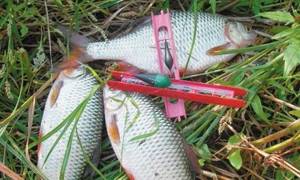
How blind rigging is made
The length of the rig with a leash should be 10–50 cm shorter than the rod, then the rod will be convenient to control.
- At the end of the main fishing line, a loop is made for attaching to the connector or to the rope at the end of the fly rod, the fishing line is cut to the required length plus (+) 0.5 meters.
- A float and cambrics with which it is attached are put on the fishing line.
- Next, a set of sinkers of such mass is attached to the fishing line that only a thin antenna of the float is above the water, and its floating body is submerged. It is recommended to make a set of two to three pellets, one of which is closest to the hook and acts as a backup.
How to set the load
The pellets are selected at the final section of the fishing line, then crimped, above them the fishing line is flattened with pliers, the pellets through this place are moved higher to an undamaged area, and the lower 0.5 meters of the fishing line are cut off and thrown away. Thus, when selecting the float weight, the main line remained intact.
The usual distribution of weights on the fishing line is a sub-weight 10–25 cm from the hook, an intermediate weight 20 cm above the sub-weight, and a main sinker 60 cm above the sub-weight. The intermediate sinker can be lowered to the sub-sink to stabilize the equipment in windy weather, during currents...
How to tie a snap
- At the end of the main line, a small loop is made to secure the leash using the loop-to-loop method.
- The main line is attached to the tip of the fly rod. There are different options - most often using a thread, or using a loop with a loop thrown over the tip of the fishing rod. In these options, a loop is tied on the fishing line of the rig for quick attachment to the fishing rod.
- The equipment is wound on a reel. Signed - the weight of the load, the diameter of the fishing line, as well as the length of the rod or its number in the arsenal. When fishing, selection and replacement of equipment can be done quite quickly.
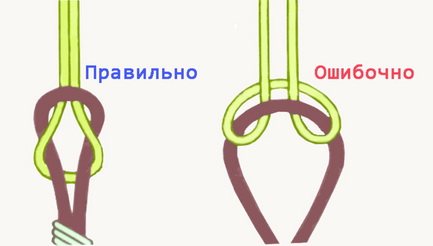
Diameters and weights for blind equipment
The lighter and thinner the equipment, the better it catches. But lightness should not interfere with controllability, otherwise the lightness will lose its meaning. The equipment must be operated confidently in all conditions. Therefore, for a fly fishing rod 5 meters long, the weight of the equipment in calm weather and with the thinnest fishing line can be 0.7 grams. The float is selected with such buoyancy. But for windy conditions and thicker lines, you may need a 2.5 gram rig, otherwise it will be difficult to cast.
As the length and rigidity of the rod increases, the blind rig needs to be made heavier.
The usual thickness of fishing line for a fly fishing rod is 0.12 mm. And the leash is 0.1mm. But in windy weather, for catching small fish, it is advisable to reduce the diameters of the lines by 0.02 - this will immediately have a positive effect on stability and catchability. For carp fishing, fishing lines of 0.15 - 0.18 m are used, while the load can reach 2.0 - 4.0 grams.
It is more advisable to use small and thin hooks - No. 16 - No. 20. But their size depends primarily on the size of the bait, as well as on the fish being caught.

How to fish with blind rigs
Let's take a closer look at some of the nuances associated with the technique of fishing with blind rigs. You must always understand how the bait is positioned relative to the bottom. To do this, a heavy pellet is attached to the hook, and at the selected fishing point, the release of the equipment is set by moving the float along the line, so that the float is in its working position.
Opposite the tip of the float, a mark is made on the rod with a marker. Now, by moving the float in one direction or another, you can clearly understand how long the leash is on the bottom or how high above the bottom the bait is.
Fishing techniques with a fly rod
For most types of fish, the most popular are three basic fishing techniques using blind rigs.
- at the bottom there is 2 - 3 centimeters of the leash;
- the bait hangs 2 - 3 centimeters above the bottom;
- the entire leash and sub-line lie on the bottom - anchoring the rig in the wind or current.
It remains to add that hooking with thin equipment must be done carefully. The same thing happens when casting. As a rule, thin equipment breaks not because of large fish, but because of the rough actions of the angler. Beginners can, as a rule, master the technique of fishing with blind rigs during the first two to three fishing trips.
Attaching the fishing line to the float rod
The reliability of the tackle, as well as the speed and convenience of replacing the equipment, depend on the method of attaching the fishing line. When assembling the fishing rod, the main fishing line can be attached via a connector or via a reel.
Attaching to a fly rod
Any fly rig must have a loop at the end, through which it will be attached to the tip of the rod. A connector is used to attach the equipment to a fly fishing rod with a float. There are three types of similar connectors:
- plastic design with lock;
- rope loop;
- a piece of rubber shock absorber.
To attach a fishing line to the tip of a fishing rod without rings, it is most convenient to use a commercial plastic connector. This element has a small clasp that closes after inserting a loop into it. There is a small hole in the connector for attaching to the tip of the fishing rod. The diameter of this hole must correspond to the diameter of the tip of the whip, so the connecting element should be selected when purchasing a fishing rod. A correctly selected connector should be pulled onto the tip of the whip with little effort. To securely fix the plastic element, the fisherman will have to use superglue.
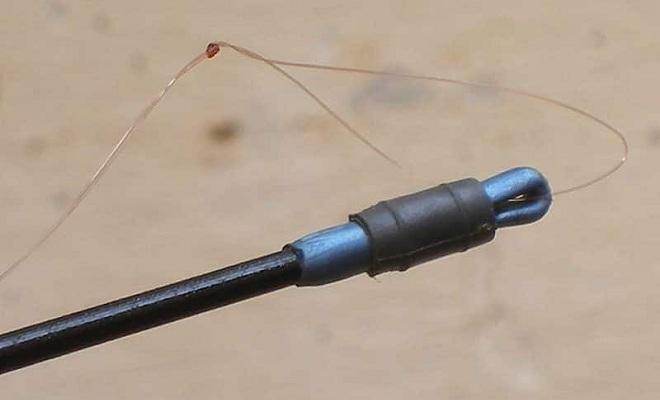
When equipping a float rod with a blind rig, a connector made from a rope loop can be used. To make it you will need:
- take a piece of synthetic rope 5 cm long and 1–2 mm in diameter;
- take a braided cord with a diameter of 0.1–0.12 mm, which will be needed to secure the rope;
- fold the rope in half;
- wind the folded rope to the tip of the whip so that you get a loop with a diameter of 0.5 cm;
- saturate the winding with superglue.
Such a connector is easy to manufacture and will allow for quick replacement of equipment. This design uses a loop-to-loop fastening method.
The third type of connector is a piece of rubber shock absorber, which can be used as bottom or plug rubber. To make it, you will need a piece of elastic 7–10 cm long, one side of which is wound to the tip of the whip with a braided cord, and at the other end a loop is formed for attaching the fishing line. This connector increases the shock-absorbing properties of the rod, which allows you to use thinner fishing line and smaller hooks.
Attaching to a Bolognese fishing rod
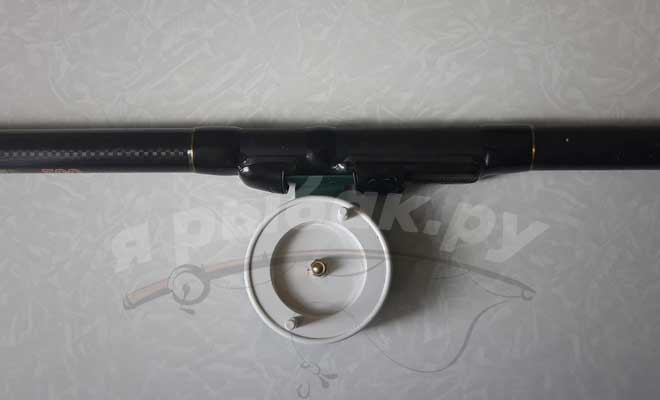
In a Bolognese tackle, the equipment is attached not to the rod itself, but to the reel that is installed on it. Most Bolognese fishing rods are equipped with a special reel seat designed for installing the reel on the tackle. If the purchased model does not have a reel seat, then you can put the reel on the fishing rod in another way. To assemble a fishing rod and reel you will need:
- drop a little superglue on the part of the reel foot that will be adjacent to the rod;
- install the reel in the center of the butt so that its spool is in line with the first wiring ring;
- fix the coil for 1–2 minutes until the glue dries;
- attach the reel foot to the butt of the rod with a braided cord;
- saturate the winding with superglue.
The tackle can be used after the glue has completely dried. A self-tightening loop can be used to attach the main line to the reel spool.
Reels for float rods
You can equip a fishing rod with a float with an inertial or inertial-free reel. The choice depends on the fishing conditions and the expected casting distance to deliver the hook and bait to the fishing spot.
The inertial reel is a reel with fishing line and has two handles for rotation. This design is equipped with a holder for mounting on the first knee. Designed for guiding fishing line through rings installed on the fishing rod.
Using an inertial reel, you can make small casts. The mechanism is equipped with a stopper to prevent spontaneous unwinding of the fishing line. There is a ratchet that is triggered when the fishing line is released during bites. The design is used on fishing rods with a length of 2 to 5 m.
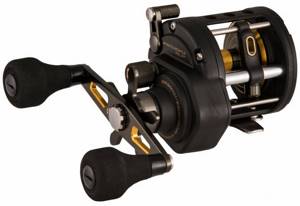
Penn Level Wind Coil
A spinning reel has a more complex design, consisting of a separate rotation mechanism with a handle and a replaceable spool attached to it, on which the fishing line is wound. A safety bracket prevents unwinding. There is a stopper. This system is designed for long casts.
How to properly equip a float fishing rod with a float
The float is the main element in the float tackle, responsible not only for timely registration of bites, but also involved in delivering the bait to the fishing point. Its performance characteristics largely depend on the method of fastening the float.
Float selection

Professionals often prefer a float weighing up to 2 grams
The fly tackle is equipped with a small float made of balsa or other materials with a high degree of buoyancy. The carrying capacity of a float for a fishing rod with blind equipment rarely exceeds 8 g. This bite alarm consists of the following elements:
- bodies;
- keel;
- antennas;
- ring for passing fishing line.
For standing water, oblong-shaped floats are used. When fishing in the current, preference should be given to spherical signaling devices. In fly fishing, the float serves only as a bite alarm and does not take part in casting the equipment.
All Bolognese floats have a drop-shaped or spherical shape, more suitable for fishing with a float rod in moderate current conditions. Bolognese signaling devices differ from flywheel signaling devices in having a greater load capacity. In addition, in the Bolognese version, the line is passed not through a wire ring, but through a hole located in the body of the float, which avoids damage to the alarm during casting and vigorous hooking.
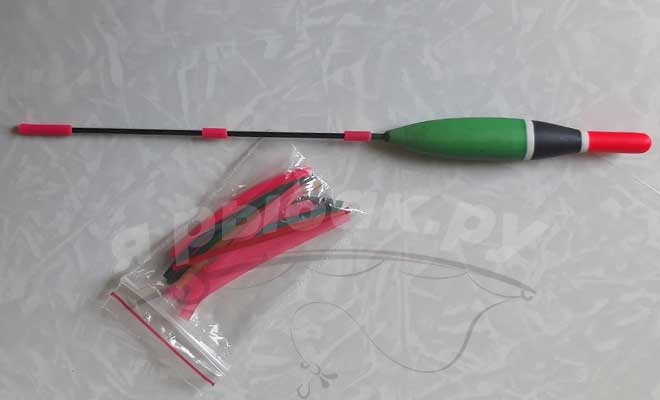
Attaching the float to the fishing line using cambrics
For match fishing, floats 20–40 cm long are used, which have their own weight and lower attachment point. This design gives the alarms good aerodynamics, which allows fishing at a distance of 40–60 m from the shore. The load capacity of match floats ranges from 2 to 25 g.
The plug-in equipment of a fishing rod for fishing in still water requires the use of light floats with a carrying capacity of no more than 1 g. For pole fishing in strong currents, flat floats are used that have excellent hydrodynamics and can withstand the directional flow of water. The load capacity of flat floats can vary from 3 to 15 g.
Attaching the float to the fishing line
The flywheel indicator is attached to the fishing line using 2-3 cambrics, which are first put on the main fishing line and then pulled onto the keel of the float. The plug and Bolognese versions are attached to the main line according to the same principle. Fastening through cambrics makes it possible to quickly change the working depth while fishing.
The match signaling device can have a stationary or sliding mount. In the stationary version, the float is attached using a special connector, which is a piece of wire with a diameter of 0.5–1 mm, with cambrics stretched over it. The signaling device is connected to the connector using a carabiner with a swivel. To assemble the sliding rig, the fisherman will need:
- tie a stop knot on the main monofilament thread;
- put a bead with a diameter of 2–3 mm on a monofilament thread;
- attach a swivel with a carabiner to the monofilament;
- attach the float to the carabiner.
With such equipment, the lower limiter, which will prevent the swivel from flying off, will be a sinker installed a meter from the hook. The working depth of fishing changes due to the movement of the stopper unit along the monofilament.
Float for crucian carp
The weight of the float for crucian carp is usually up to 5 grams. 1-2 gram floats are considered light. 1 gram is too little, after all, we’re not catching a hive. The mass of the float for crucian carp is 2-3 grams, or rather, this carrying capacity is just right, the equipment is both sensitive and flies normally on long casts. What is more important here is not the size of the float itself - but the fact that the pellets in the load do not exceed 2-3 grams. The crucian carp does not feel them in this case when it lifts the rig from the bottom. Heavy floats fly well, however, they work poorly for crucian carp in a weak bite if they are loaded incorrectly (more on this later). So, float size is a matter of personal preference. You can use both large and light ones. However, on large floats it is necessary to use sensitively spaced weights, and not place one heavy weight, otherwise such tackle will only work during a good, bold bite, for example, during the spring run.
I myself always use 2-3 gram floats or a goose feather. And in a strong current, where there is no way to stand, I simply fish with a wire, a tightness at an angle to the shore, by floating, or even with a feeder. With such huge floats, which I sometimes notice among fishermen on the shore, I often catch a predator with live bait, rather than peaceful fish. And I have this type of fishing rod rig - not only for crucian carp, it is the same all year - whether for roach, carp or bream. I change leashes and hooks (for carp, of course, without a leash, the hook is on the main line).
How to choose floats for catching crucian carp
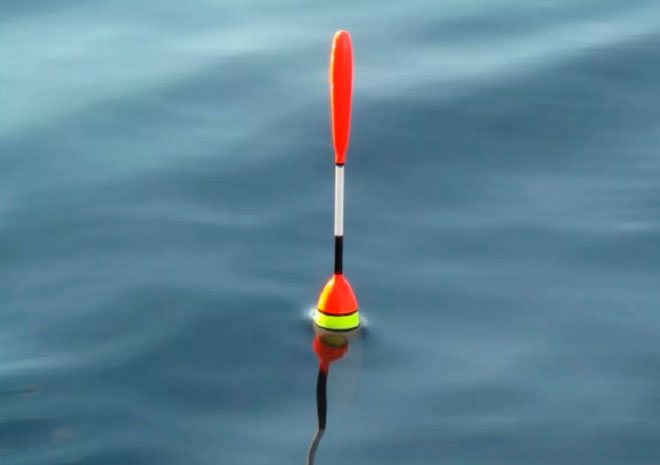
Proper float loading
A properly loaded float allows you to register the most careful bites. To properly load the float, the fisherman needs to have a weighted set of weights and small pliers.
How to load a float on a pond
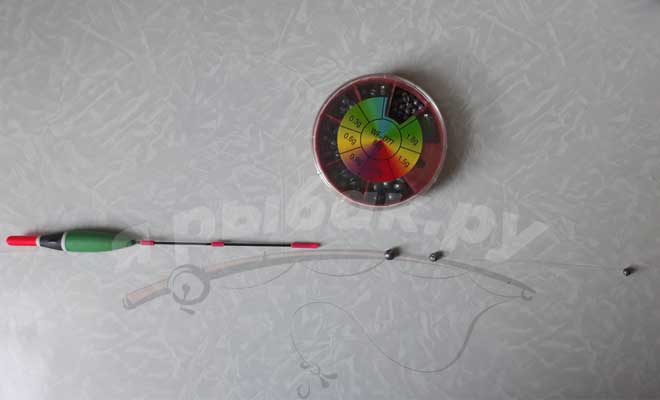
Loaded float with two pellets and a pad
Having a set of lead pellets with him, an angler can quickly equip a fishing rod right on the shore of a reservoir. To load the bite alarm you will need:
- fasten the sinker at the junction of the leash and the main fishing line;
- clamp the main part of the sinkers, whose mass is equal to 2/3 of the load-carrying capacity of the float, one meter above the feeder;
- the rest of the pellets are secured between the sub-frame and the main set of sinkers until only half of the antenna is visible above the water.
If you plan to fish with large baits that have a significant own mass, then the float can be slightly underloaded.
How to load a float at home
At home, a bite alarm is placed in a high container, with a piece of fishing line about 10 cm long attached to its keel. The fisherman sequentially clamps weights of varying weights on a piece of monofilament until the desired position of the float in the water is achieved.
Having loaded the alarm with half of the antenna, the fisherman removes the pellets and installs them on the working equipment. The density of water in a pond may differ from that at home, so you should always have at least 1-2 pellets with you to reload the float.
Blind float equipment
Let us repeat that the blind rigging of the float itself means that the float does not slide, but is held fixedly on the fishing line due to the high friction between the fishing line and the float.
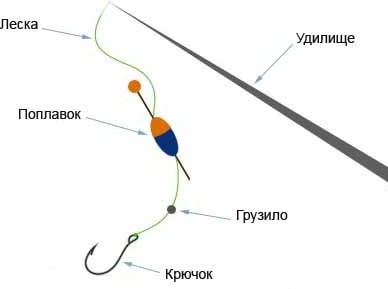
This effect can also be achieved by using two stoppers, which are pressed closely to the float and completely limit its movement.
My personal opinion is that it is better to use a sliding float, as when casting the float is at the very bottom, which is convenient. It is easier to make long casts, as well as casts in strong crosswinds.
Leash attachment
It is impossible to assemble a fishing rod correctly if you do not think about such an element of equipment as a leash. This part is very important because it has direct contact with the fish during fishing.
What should a leash be like?
This element of the float rod equipment should be 0.02 mm thinner than the main fishing line, which will ensure the safety of the equipment when the hook is caught. The leash is knitted from high-quality monofilament with a diameter of 0.06–0.16 mm. The length of the leash for fishing in a still water body is from 12 to 30 cm. When fishing in a current, the length can increase to one and a half meters.
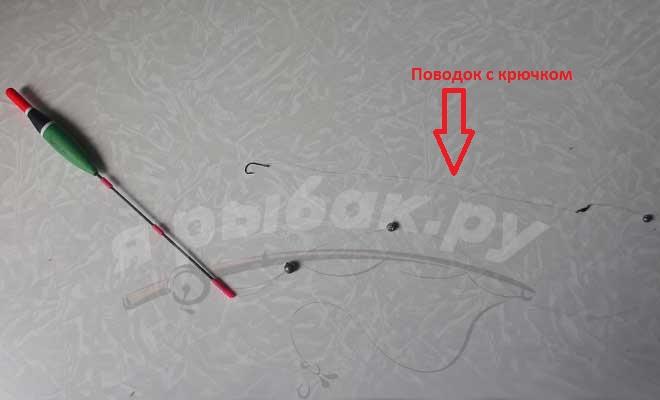
Leash with hook attached using a small swivel
When fishing, you must ensure that the leash does not twist. If a fisherman notices any damage to the leader line, the leader must be replaced immediately.
How to connect a leash to a fishing line
If fishing takes place on a lake or reservoir, in the complete absence of current, then the leash is connected to the main monofilament using the “loop to loop” method. When it comes to fishing in flowing waters, the leash should be attached to the main line using a small swivel, which will prevent it from twisting during fishing.
Photo of the float rod equipment
Note!
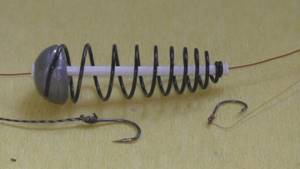
Fishing with a spring - rigs, baits, baits, gear and methods of fishing with a spring (80 photos)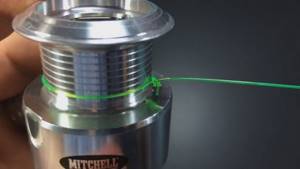
How to tie a fishing line to a reel - methods, tips on how to tie correctly and an overview of the most reliable knots (85 photos and videos)

Cuts for wobblers and spinners - how to make a simple homemade cut. 110 photos and videos of practical tips
Help the project, share on social networks 

0
How to properly tie a hook to a fishing line
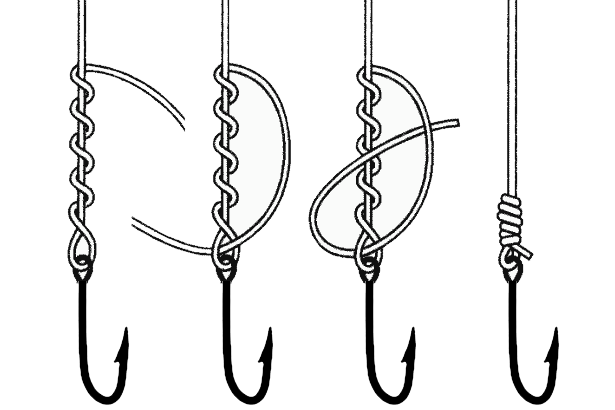
When installing a float rod, you should pay special attention to the selection and tying of the hook. The degree of realization of bites largely depends on this element of equipment.
Hook selection
When fishing with a worm, barley or corn, hooks of the classic shape No. 12–4 (according to the international classification) are used. To fish for maggots or caddis flies, use hooks No. 16–12. If the angler uses bloodworms as bait, then the hooks should be made of thin wire and correspond to the number 24–18. When fishing with dough or other soft baits, it is better to use hooks with a spring coil. A small spiral will reliably hold the soft bait during the fishing process.
Float for fly fishing rod
The choice of float depends on what kind of float equipment is used - blind or sliding. When sliding equipment, special sliding floats are used, which are fixed with rubber stoppers. Blind tackle involves attaching the float blindly to the fishing line using an elastic nipple.
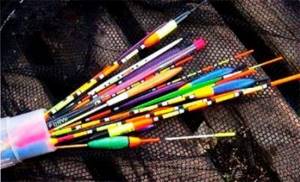
Also, the selection of a float directly depends on the nature of the fish bite and the fishing location. For example, for catching small crucian carp or roach, a light, sensitive float that responds to the slightest fish bite is suitable, and for catching carp, you can use a massive float. When fishing in large waters, there is often a wave; many anglers specifically choose floats that swing on the waves, where the bite is better visible.
When choosing a hook for a float rod, as when choosing most components, one is guided by the same intended fishing objects. Most often, hooks of size No. 3-5 are chosen; in addition, hooks with a long shank are mainly used for animal baits.
To fully equip a float fishing rod, it’s up to the weight; it is selected based on the float; often the final adjustment of the size of the weight takes place right on the pond, where the position of the float is checked at different depths.
Fishing with a float rod is a very exciting phenomenon; thanks to such gear, the bite and control of fishing are very well felt. Video on the topic:
Float fishing - Mistakes of novice fishermen
31:42
Tackle for summer fishing rod. Sliding float and weight. My fishing.
08:45
Tip #4 - Float rod. Float rod equipment for fishing
27:37
narybalke
How to knit
If the hook is tied correctly, the monofilament practically does not lose its breaking load at the knot. To properly attach the hook you need:
- turn the hook with the back side facing you;
- pass the end of the monofilament through the eye and attach it to the fore-end;
- point the end of the fishing line towards the eye;
- wrap the monofilament around the shank 5–6 times and pass its tip into the loop formed at the bend of the hook;
- moisten with saliva and tighten.
Wetting the assembly when tightening will prevent it from burning out. The tip remaining after tying must be cut off.
